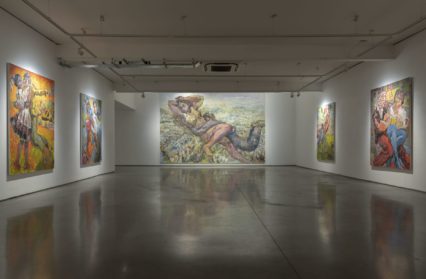Gary Raymond reviews the paintings from Kevin Sinnott’s latest exhibition, Liebestod, which brings together new and recent works, many of them created during the pandemic.
And so, is this how the pandemic ends, not with a whimper, but with a BANG!? Kevin Sinnott, for one, has no intention of emerging from the last two years blinking meekly into the sunlight. His new exhibition, Liebestod, at the Flowers Gallery in London until the end of February, is, to a certain extent, about questions of scale. His new work leans toward the epic in physical size whilst seeming simultaneously intimate – he has called it “operatic”, and it certainly fills the main room with that kind of statement of the human made large. But as well as operatic, they are also cinematic, because they hang there on the wall like the silver screen. Although often rendered in bold colours made ephemeral with a soft touch, there is something of the British cinema about this lockdown collection, Ealing in Technicolour, and something about the stiff upper lip, and what happens when those lips relinquish to a tremble.
Thank goodness, then, that Sinnott has not gone for the bleakness of the recent difficult times as his aesthetic theme. These paintings are vibrant, full of the bristling stuff of life (and death – hence the title), even when allowing the supine and physically inert to take centre stage. The tension is often between the use of colour and the idea of mental exhaustion. Figures dance and swoon, but is this freedom or the last days of a dying kingdom? Either way, there is a sense of relief in these paintings. Women are the girders of Liebestod’s universe. This is obvious in works such as ‘Supermam’, ‘Strong Woman’, and ‘Goddess of the Dawn’ (Sinnott doesn’t mess about with his titles) in which the female characters grip and hoist and elevate, but there is also a coldness, a reticence, at the core in their relationship to the men of the paintings. To the children in Sinnott’s frame it’s different – relief becomes play – but men here are almost always figures to be rescued and maybe even pitied. It’s unclear whether the pity is best to be served as a passive gesture, but what the men are certainly not is the inversion of the damsel. Get up, you want to shout at them, rather than, Is there anything I can do to help?
Liebestod the exhibition is dominated by ‘Liebestod’ the painting, a gigantic work described in the programme as Sinnott’s most ambitious to date. And it is something to be lived with, drawn from, returned to. The two figures recline across a quilted landscape of fading Welsh valleys terraces, somewhere between Gulliver and the famous beach embrace in From Here To Eternity. But the male figure is pleading for solace in the reluctant midriff of a woman who holds all the power, her dress tinged with gold tubing like the warriors of Wonder Woman’s island home. It could also be post-coital, or pre-coital. There is a hint of Cider with Rosie, the quiet joy of intimacy as the world burns; but they also seem lavish like gods.
Perhaps the most subtle and interesting works, the ones on which the mind lingers longest, are those of the ‘modelling’ sequence. A man and woman focus on their notebooks in a series of insulating poses. The male in ‘Modelling Together’ is a squirm of geometrical questions within his old suit, whereas the female is considered and clear. Their legs intertwine in the abstract setting, but it is obvious their work is separate. In ‘Modelling’ similar – or the same? – figures stand and sketch shoulder to shoulder. In ‘Isolation’ the same female figure appears, dim collages of life getting on during lockdown in the near distance behind her.
Liebestod is at its best when the lines between the figurative and the metaphorical are blurred. And so ‘Pantygog’, which very much plays on a riff of Delacroix’s ‘Liberty Leading the People’ (1830), offers up a powerful image of the role of women in times of societal hardship and upheaval whilst obliterating the lazy and damaging clichés surrounding Welsh women that remain abundant in mainstream culture (Siobhan Denton wrote a blistering exploration of this trend for Wales Arts Review in 2017).
For many of these works, Sinnott excavated ideas from thirty years of sketchbooks, but rather than this perspective resulting in an erratic set of themes, it has had the result of creating a unifying understanding of Sinnott the artist-as-a-whole. His psychological preoccupations are up there to be admired, and there is even a suggestion that some of the ideas of yesteryear have been given time (as well as the opportunity of the pandemic) to come into their rightful place in the journey of Sinnott’s development. Liebestod is a forceful, rhythmic collection, rich with symbols and images that will resonate with anyone familiar with his work but offered up with a renewed verve and vitality. Without doubt, a BANG! and not a whimper.
Kevin Sinnott’s Liebestod is at Flowers Gallery, London, until the 26th of February.
Gary Raymond is a novelist, critic, and broadcaster, and is editor of Wales Arts Review.



 Enjoyed this article? Support our writers directly by buying them a coffee and clicking this link.
Enjoyed this article? Support our writers directly by buying them a coffee and clicking this link.








